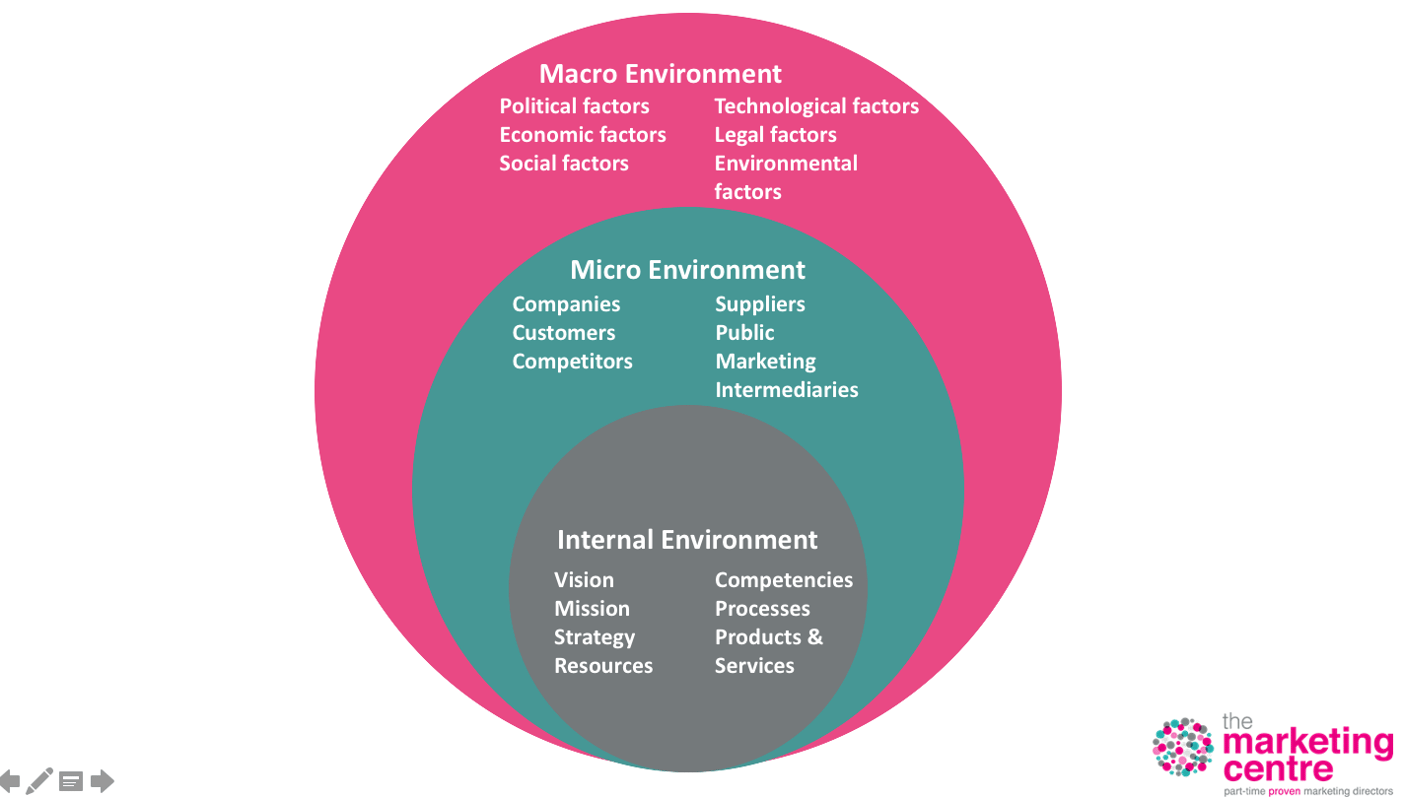It is really important to thoroughly understand your markets, customers and general environment within which they are making decisions. Without this knowledge you certainly can’t set a solid marketing strategy that will target the right customer, improve sales and get your business the growth that it needs!
There are major benefits to understanding your customer:
- Better focused marketing efforts
- Improvements to your customer service
- Opportunities are created to build loyal relationships
- Products can be better developed
- Customise features can be created
- Understanding your customer also involves understanding the market they are in - your market...
When exploring the marketing environment of a business it’s important to remember that we are talking about both your internal environment (employees, owners, workers, machinery and materials etc) and external environment (customers, suppliers, competitors and all external (macro) forces.
ALL factors should be considered, even if only briefly, when doing a market analysis. But for the sake of this resource we will be focusing on the Customer analysis.
This diagram gives a simple breakdown of the marketing environment of a business, showing all elements, and where the customer fits in:

Here are a few starter ideas of how to gain a better understanding of your customers:
1. Use your financials and/or CRM to Identify your most and least profitable customers
2. Create a survey – for existing customers, past customers, and potential customers
3. Do a ‘who, where, what, when, how analysis’ – this is the most basic level of customer analysis.
- Who are they? Age, gender, income, education level, occupation, marital status and number/age of children
- Where are they?Domestic vs international, region, city and market size, rural vs urban. It is SO important to understand the geographic concentration or diversity of your customers.
- What– what do they think? What do they do? What have they done? What are they likely to do in the future?
- When – are there seasonal or special occasions that you need to understand about your customer interaction with you?
- How – literally, how do your customers interact with your product or service… eg online vs in-store, reseller vs direct etc.
What to do with this customer information?
1. Use the generic “4-types of customer segmentation” to segment your customers:
- Geographic segmentation.
- Demographic segmentation.
- Psychographic segmentation.
- Behavioral segmentation.
Once you have all of this information you will want to estimate the size and value of each segment – cross tab your segments to see if patterns emerge, eg percentage of customers over 65 and percentage of customers in urban vs rural areas. There is a more advanced technique called a cluster-analysis, which identifies statistical patters, but we suggest specialised assistance to do this.
2. Build your customer persona
Persona’s are a more personal segmentation or profiling tool – we create a character profile that is a representative of a customer group who share similar needs, traits, values and beliefs. And this ‘persona’ normally comes with a catchy name that helps the internal team with memorability. It’s far easier to remember the traits of a ‘person’ ie persona, than it is to remember the breakdown of a customer segment.
Segmentation techniques often rely on detailed quantitative data and are used to build marketing strategies to reach the end user. Persona’s on the other hand, are usually built using qualitative data that has been gathered using interviews and focus groups and are more often used early in the marketing process to give prospects and customers personalities and preferences.
We don’t see persona’s and segmentation as one-or-the-other techniques but rather as two complementary tools, one giving a broader view and the other drilling down and really personalising the process.
To get a full, unbiased picture of these many customer related components we recommend that a fair amount of research is conducted, including internal interviews, desktop research and if needed, further specialised research into areas where limited or access-controlled information is available.
The information gathered by any form of market analysis should never just sit in a file gathering digital dust! It is hugely valuable to use in a business SWOT analysis. Categorise your findings into internal Strengths and Weaknesses and the external Opportunities available and potential Threats in your market.
You can take your SWOT analysis a bit further and agree on some Quick Wins – easy action points that will have a big impact. And you could also add ratio’s to your SWOT to weight the importance of each element.
Marketing Director Tip:
Include your key stakeholders in a SWOT workshop, and once all of your discussion points are up on sheets of paper/white boards, vote anonymously with stickers – walk around the meeting room and put stickers next to the items you think are most important. You should see a few trends emerging.
If this process is out of your area of expertise or capacity, please get in touch. One of our part-time Marketing Directors can walk you through the process step by step. They will help you focus your efforts, see return on your investment and grow your business.




